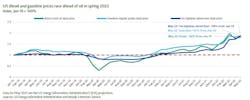Moody’s: Rising fuel prices will undermine oil demand growth
Crude oil prices have fluctuated between $100-120/bbl since the Russian-Ukrainian war erupted in late February. Several competing demand and supply forces are driving oil prices, and their near-term trajectory will depend on how these forces evolve. In a newly released report, analysts at Moody's said they expect high and volatile oil prices—and extremely high fuel prices in summer 2022—to dampen oil demand growth, reduce projected supply deficit, and lead to lower oil prices in 2022-23.
“Oil prices climbed steadily since pandemic-trough in April 2020, propelled by insufficient investment by the industry and slow recovery in oil supply amid fast recovery in demand for oil. While oil prices surged well above the $50-70/bbl, that we estimate supports profitable reinvestment by the industry, growth in capital investment and supply remains elusive, reflecting a fundamental change in capital allocation frameworks, a focus on shareholder returns and rising regulatory and financial risks managed by producers,” the analysts said.
Demand for oil will start to wane as prevailing high oil prices coupled with rising interest rates dampen economic growth. The US Energy Information Administration (EIA) early this month reduced its 2022 global oil and fuel consumption forecast to 99.6 million b/d, down about 1 million b/d from its estimate at the start of the year (OGJ Online, May 10, 2022).
“Oil demand largely depends on consumption of fuels, such as gasoline and diesel. High frequency mobility data points to a broad decline in mobility trends across all major markets since the start of the Russia-Ukraine crisis. At the same time, fuel prices are rising much faster than oil prices, driven by spreading physical shortages of fuels because of reduced supply from Russia and low inventories. Europe, which imports about 40% of its diesel from Russia, is especially exposed. Rising demand for US fuel exports is pushing traded prices for diesel and gasoline to significant premiums over current oil prices, exacerbating pressure on consumers,” the analysts continued.
The Ukraine war has exacerbated supply uncertainty and will continue to be the source of rising geopolitical risk premiums and wild swings in oil prices this year and next.
“Russia is the second largest exporter of oil and the largest exporter of fuels to Europe. The conflict has left oil markets more dependent than ever on policy levers, such as sanctions, embargos and other trade regulations. The European Commission’s proposed plan to ban Russian oil imports by the end of this year, if implemented, will amplify the imbalances in the global oil market and cause sharply higher oil prices and shortages of petroleum fuels. The plan, however, is stalled by resistance from several member states, including Hungary and Slovakia. These two countries have the highest risk exposures to the potential embargo on Russian oil because of their landlocked position and limited options for alternative supply to national refineries configured to process heavier Russian crudes,” Moody’s analysts said.
“So far, sanctions against Russia have increased the likelihood of a material loss of supply. New trade restrictions are forcing a hasty reordering of energy trade flows and a rebalancing of established regional pricing patterns. At $100-120/bbl, the oil market is likely pricing in a disruption to Russian export supply of about 1 million b/d in 2022 (about 1% of the projected demand). We expect that the release of strategic petroleum reserve (SPR) by the US will provide around 1 million b/d of additional supply over May-October this year and therefore reduce pressure on rising oil prices during the summer season, while both supply and demand continue to adjust to the new trade order. Should Russian export volumes fall by more than the expected 1 million b/d in 2022, and especially if such decline in supply were to exceed global spare production capacity, oil prices could rise sharply for an extended period of time,” they continued.
Structural supply imbalances caused by underinvestment are likely to persist for years and will require a stronger response from producers. In the short term, however, rising demand risks will lead to lower oil prices by end 2022. The Russia-Ukraine war remains a big source of uncertainty, but any additional supply disruptions and soaring oil prices will ultimately accelerate a decline of oil demand, the analysts concluded.
